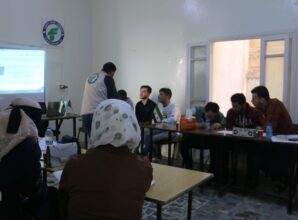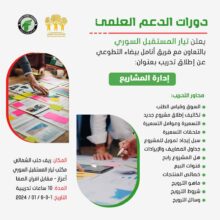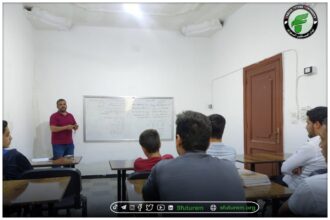What is the concept of One Health?

Introduction: Dr. Mahmoud Wazzaz
What is the One Health Project?
It includes a wide range of stakeholders and actions in the fields of agricultural sustainability, animal and plant health, forestry, aquaculture safety, food safety, antimicrobial resistance, food security, nutrition, and livelihoods.
The U.S. Centers for Disease Control and Prevention estimate that each year, around 2.6 billion people suffer from zoonotic diseases, and approximately 2.7 million people die from them.
Why does Syria need the One Health Project?
Addressing Zoonotic Diseases:
Many infectious diseases, such as leishmaniasis, tuberculosis, and brucellosis, have long incubation periods, and refugees may contract these infections, with the risk of their re-emergence in neighboring countries. An increase in leishmaniasis cases has already been reported in Syria, and it is likely to be observed among refugees as well. Epidemics of bacterial meningitis and gastrointestinal infections like Hepatitis A, enteroviruses, and giardiasis can be anticipated.
Food Security and Nutrition:
Syria is among the six countries with the lowest levels of food security globally. By the end of 2022, 12 million people were experiencing food insecurity, and 2.5 million were suffering from severe food insecurity. Individuals in these categories make up more than half of Syria’s total population.
Antimicrobial Resistance:
In the Syrian Arab Republic, in 2019, there were 1,700 deaths attributed to antimicrobial resistance and 6,400 deaths related to antimicrobial resistance. Syria ranks 96th in terms of the highest age-specific mortality rates per 100,000 population related to antimicrobial resistance among 204 countries.
Environmental Health:
Deforestation, overgrazing, soil erosion, desertification, water pollution from untreated sewage and waste from oil refining, and insufficient supplies of potable water.
Strengthening Health Systems:
Enhancing resource exchange between health and animal sectors thereby promoting public health.
The following is a table of cases of leishmaniasis and typhoid fever in Aleppo and Idlib governorates, prepared by the Support Coordination Unit.

When Do We Need the One Health Project in Syria?
Additionally, internally displaced persons camps often face difficulties accessing services such as clean and sanitary water and medical care, creating a high-risk environment for disease outbreaks. For instance, cholera has resulted in 101 deaths and infected over 92,000 people so far, which is 18% of all suspected cases. Cases have been reported from displacement camps as of March 16, 2023.
Therefore, we recommend taking immediate steps to launch the One Health Project in Syria.
Where? What are the proposed areas to start the Syrian One Health Project?
The population in northwestern Syria is 4.5 million according to OCHA statistics, and the camp population is 2 million according to the same statistics at the end of 2023. This high population density in camps presents a vital environment for the spread of epidemic diseases due to overcrowded living conditions, inadequate sanitation and hygiene facilities, and limited access to clean water and healthcare. The displaced population is particularly susceptible to these diseases.
Some common environmental diseases in displacement camps:
- Waterborne Diseases: Cholera, typhoid fever, dysentery, Hepatitis A
- Vector-borne Diseases: Malaria, dengue fever, leishmaniasis, Chagas disease
- Respiratory Diseases: Pneumonia, tuberculosis, COVID-19 (during outbreaks)
- Skin Diseases: Scabies, impetigo, fungal infections
- Diarrheal Diseases: Rotavirus, bacterial diarrheal diseases
How to Start the One Health Project in Syria?
The Four Pillars of the One Health Project:
- Communication
- Coordination
- Collaboration
- Capacity Building
Main Goals:
- Achieve comprehensive health for all through a holistic approach focusing on prevention, health promotion, and treatment.
- Reduce health disparities among different community groups.
- Improve the quality of health services provided.
- Enhance the efficiency of the health system.
Main Strategies:
- Focus on disease prevention and health promotion through awareness and education programs.
- Improve primary healthcare systems to provide high-quality services to everyone.
- Promote integration between different components of the health system.
- Empower individuals and communities to manage their own health.
Key Initiatives:
- Launch health awareness campaigns on topics like proper nutrition, physical activity, and mental health.
- Expand early disease screening programs.
- Improve the quality of health services provided in primary healthcare centers.
- Establish an integrated health information system.
- Support health research programs.
Funding:
All interested supporters of sustainable development and One Health projects, including the European Union, World Health Organization, Food and Agriculture Organization, World Organization for Animal Health, United Nations Environment Programme, and other global supporters.
Responsibilities:
The Syrian Future Movement and its expertise in health in northern Syria, with potential collaboration with local organizations or the establishment of a specialized One Health organization under the name ONE HEALTH if approved for a comprehensive project for all of northern Syria.
Evaluation:
The One Health plan will be evaluated periodically to ensure that the goals are met, with the project attached to an internal monitoring and evaluation team and a team for learning from previous experiences and other countries.
Timeline:
The One Health plan will be implemented over three years from 2024 to 2026, according to the WHO plan.
Expected Impacts:
- Improved public health.
- Reduced health disparities among different community groups.
- Enhanced quality of health services.
- Increased efficiency of the health system.
One Health and UN Goals:
- Goal 3: Good Health and Well-being for All
- Goal 6: Clean Water and Sanitation for All
- Goal 13: Climate Action
- Goal 17: Partnerships for the Goals
One Health and World Bank Goals:
- Eradicate Extreme Poverty
- Promote Shared Prosperity
- Address Climate Change
Opportunities for Success of the One Health Approach in Northern Syria:
- Support from international organizations
- Community involvement
- Inter-sectoral collaboration
- Scientific research
Examples of Successful One Health Approaches in Northern Syria:
- Reducing the spread of infectious diseases
- Improving maternal and child health
- Preventing chronic diseases
Challenges of the One Health Project in Syria:
- Resource shortages
- Institutional weaknesses
- Social and cultural challenges
- Environmental challenges
- Security challenges
- Reconstruction
- Refugees
- Climate changes
- Food shortages
Strengths of the One Health Project in Syria:
- Comprehensive approach across sectors
- Improving human, animal, and environmental health
- Enhancing disease prevention
- Improving epidemic response
- Promoting scientific research
- Building capacities
- Enhancing international cooperation
- Achieving sustainable development goals
- Improving quality of life
Weaknesses of the One Health Project:
- Coordination challenges
- Funding shortages
- Data gaps
- Lack of awareness
- Resistance to change
Finally, we always remember that prevention and preventive medicine are more comfortable and cost-effective than falling into diseases and treatment difficulties. We conclude with the famous Arabic proverb: “An ounce of prevention is worth a pound of cure.”
Dr. Mahmoud Wazzaz
Scientific Office
Independent Researchers






